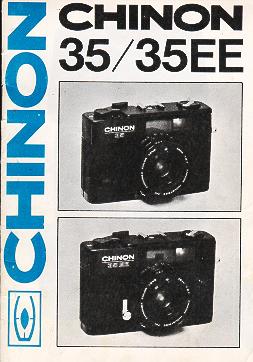This camera manual library is for reference
and historical purposes, all rights reserved.
This page is copyright© by M. Butkus, N.J.
This page may not be sold or distributed without
the expressed permission of the producer
I have no connection with any camera company.
If you find this manual useful,
how about a donation of
$3 to:
M. Butkus, 29 Lake Ave.,
High Bridge, NJ 08829-1701
and send your e-mail
address
so I can thank you.
Most other places would charge
you $7.50 for
a electronic copy
or $18.00 for a hard to read Xerox copy.
buy new manuals, and pay their shipping costs.
It'll make you feel better, won't it ?
If you use Pay Pal, use the link below.
Use the above address for a check, M.O. or cash.
Back to main camera manual page

Click here for the Chinon 35 FS-A PDF
of this page, better printing
35/35 EE COMPACT
|
1. Film winding lever 2. Film rewind lever/Back cover release 3. Flash contact and shoe 4. Film counter window 5. Shutter release button 6. Strap lug 7. Self-timer lever (35 EE Only) 8. Film rewind release button 9. Tripod screw 10. Battery compartment cover 11. Lock for function control ring 12. DIN film speed 13. ASA film speed 14. US electric eye 15. F 2.7 38mm lens |
16. ASA/DIN setting ring 17. Focus ring 18. Viewfinder 19. Flash cord socket 20. Function control ring 21. Back cover 22. Film compartment 23. Guide rail 24. Sprocket 25. Film take up spindle 26. Film counter setting pin 27. Eye piece 28. Pressure plate 29. Film roller 30. Rewind spindle |
INSTALLING THE AUTOMATIC EXPOSURE CONTROL (ELECTRIC EYE) BATTERY(Fig. 4, 5)
The US electric eye is powered by a long-life 1.3V
mercury battery (Mallory PX-675 or equivalent).
The battery is supplied with your camera
either installed, or packed separately in the camera box.
See this link on a Wein Air replacement battery.
To install the battery, use a coin to unscrew. Drop the battery into the opening with its positive (+) side up and replace the battery cover. When you replace the battery, wipe the fresh battery with a clean dry cloth. The average life of the battery is one year.
(Fig. 6, 7, 8, 9)Lift up the FILM REWIND KNOB/BACK COVER RELEASE until the back cover snaps open.
Drop the 35mm film cartridge (12, 20 or 36 exposures) into the left chamber. Press in the film rewind knob and fold the rewind crank.
Pull out the end of the film and insert the end into any slot of the FILM TAKE-UP SPINDLE. Advance the film by turning the film winding lever. Repeat until the sprocket teeth engage the film perforations on both top and bottom and place in the guide rail properly. Close the back cover firmly. Press the SHUTTER RELEASE BUTTON and advance the film forward. Repeat until No. 1 is visible in the FILM COUNTER WINDOW. The camera is now ready to shoot the first picture.
AUTOMATIC EXPOSURE (Fig. 10, 11)
Turn the ASA/DIN setting ring on the top of the lens and set the ASA speed in accordance with your film rating. Make sure the ASA rating is as indicated on the data supplied with the film. The ASA speed rating appears
in the slot on the top of the lens and the DIN rating in the slot on the bottom of the lens. Hold the lock lever for the FUNCTION CONTROL RING and rotate until it snaps into the AUTO index position. Exposure is then automatically programmed for the automatic shutter speed and lens iris setting for any picture taking.
VIEWFINDER (Fig. 12)
All the information necessary for composed and perfectly exposed picture is indicated in the viewfinder.
Parallax Mark (a)
When taking the pictures closer than four feet (1.5m) from the camera to the subject, the
subject should remain within the yellow parallax frame.
Too bright light conditions (b)
When the light is too bright for taking a picture,
the needle moves into the upper red warning zone. Use an ND filter (Neutral Density Filter) for the lens to cut down the light.
Proper exposure (c)
If the exposure needle stays between the top and bottom red signal zone, the proper exposed films will be produced.